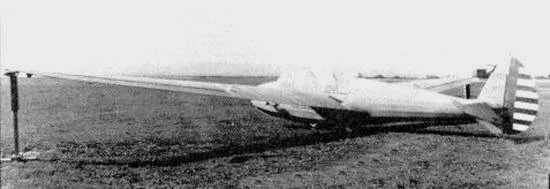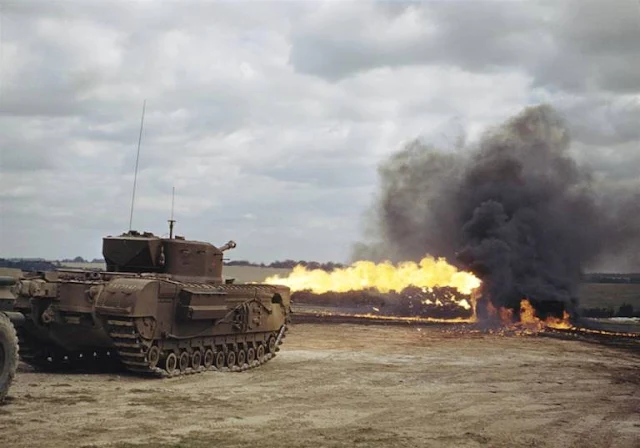 |
| Chase XCG-14 (44-90989) glider being towed aloft. 1945. |
 |
| Chase XCG-14A. |
 |
| Chase XCG-14 (44-90989). |
 |
| Chase XCG-14 (44-90989). |
 |
| Chase XCG-14 (44-90989). |
The World War 2 In Review blog features numerous articles and photos on World War 2 history topics, including military aircraft and warplanes, vehicles and AFVs, warships and naval vessels of World War 2; battles and operations in every theater of World War II; accounts by combatants and non-combatants during World War II; coverage of uniforms, insignia, weapons, and equipment used in WWII; strategy and tactics of World War 2; and much more.
 |
| A U.S. Navy XLRQ-1 glider at the Bristol Aeronautical Corporation in Bristol, Connecticut, 1942. |
 |
| A U.S. Navy XLRQ-1 glider at the Bristol Aeronautical Corporation in Bristol, Connecticut, 1942. |
 |
| A Consolidated PBY Catalina towing the Bristol XLRQ-1 on the Delaware River during flight testing. 1943. |
 |
| A U.S. Navy XLRQ-1 glider at the Bristol Aeronautical Corporation in Bristol, Connecticut, 1942. Note the Martin JM-1 Marauders in the background. |
 |
| A U.S. Navy XLRQ-1 glider at the Bristol Aeronautical Corporation in Bristol, Connecticut, 1942. |
 |
| A U.S. Navy XLRQ-1 glider at the Bristol Aeronautical Corporation in Bristol, Connecticut, 1942. Note the Martin JM-1 Marauders in the background. |
 |
| Curtiss XP-42, 23 February 1942. |
 |
| Curtiss XP-42 (short nose version). |
 |
| General H.H. Arnold standing alongside a TG-2 glider, with Capt. Ralph S. Barnaby (left) and Edward S. Evans (right), at Harris Hill, Elmira, New York. 1941. |
 |
| TG-3A. The 2-12 succeeded the 2-8 in production and 114 were produced with the designation TG-3A. Three prototype TG-3s were constructed under the designation XTG-3. |
 |
| Schweizer TG-3A training glider. |
 |
| Schweizer TG-3A training glider, National Museum of the Air Force. |
 |
| Schweizer TG-3A (44-486136) training glider, U.S. Army Air Forces, Pima Air and Space Museum. |
 |
| The Laister-Kauffman TG-4A displayed at Air Mobility Command Museum. |
 |
| Laister-Kauffman TG-4A, Fort Rucker. 1942. |
 |
| Laister-Kauffman TG-4A. |
 |
| Laister-Kauffman TG-4A being readied for a factory test flight. |
 |
| Laister-Kauffman TG-4A on a factory test flight. |
 |
| Laister-Kauffman TG-4A. |
 |
| Laister-Kauffman TG-4A. Note the open rear canopy! |
 |
| Laister-Kauffman TG-4A. |
 |
| Laister-Kauffman TG-4A, “515,” contract glider school, Wickenberg, Arizona. Note the shark mouth on the nose. |
 |
| Laister-Kauffman TG-4A. |
 |
| Laister-Kauffman TG-4A. |
 |
| Laister-Kauffman TG-4A. |
 |
| Laister-Kauffman TG-4A. |
 |
| Laister-Kauffman TG-4A. |
 |
| Laister-Kauffman TG-4A during construction. |
 |
| Laister-Kauffman TG-4A during construction. |
 |
| Laister-Kauffman TG-4A hatch cover assembly. |
 |
| Laister-Kauffman TG-4A spoiler and brake system. |
 |
| Laister-Kauffman TG-4A tow hook — closed and open. |
 |
| Laister-Kauffman TG-4A — location of parachute tube. |
 |
| Laister-Kauffman TG-4A being inspected by General Yount, contract glider school, Lamase, Texas. |
 |
| Aeronca TG-5 training glider was a conversion of an Aeronca light plane by removing the engine and replacing it with a nose for a third crew member. |
 |
| Taylorcraft TG-6 (42-58662), U.S. Army. On display at the Pima Air and Space Museum. |
 |
| A Churchill tank fitted with a Crocodile flamethrower in action. This flamethrower could produce a jet of flame exceeding 150 yards in length. August 1944. (Imperial War Museum TR 2313) |
 |
| Churchill tanks of A and B Squadrons, 43rd Battalion, Royal Tank Regiment, 33rd Brigade negotiate obstacles during training, October 1942. |
 |
| A Churchill tank of the North Irish Horse crossing the Senio in Italy on two stacked Churchill ARKs, Italy. April 1945. |
 |
| Churchill Crocodile training in England. |
 |
| Churchill infantry tank and crew. |
 |
| Churchill AVRE (Armoured Vehicle Royal Engineers) close-support vehicle. |
 |
| Churchill Crocodile with its flamethrower fuel trailer that carried 400 gallons. |
 |
| Churchill tank in Italy. |
 |
| Churchill Crocodile flamethrower tanks move forward near Imola, Italy, 12 April 1945. |
 |
| The Crocodile’s flamethrower system. |
 |
| A Churchill Crocodile sends some 'love' down range. |
 |
| Churchill Crocodile flamethrower tank, 79th Armoured Division, 13 February 1944. |
 |
| Churchill Crocodile flamethrower on trials, Eastwell Park, Ashford, Kent, 26 April 1944. |
 |
| Churchill Crocodile flamethrower in action during trials at Eastwell Park, Ashford, Kent, 26 April 1944. |
 |
| Churchill Crocodile flamethrowers in action during trials at Eastwell Park, Ashford, Kent, 26 Apr 1944. |
 |
| Churchill Crocodile flamethrower in action during trials at Eastwell Park, Ashford, Kent, 26 April 1944. |
 |
| Churchill Crocodile flamethrowing tank during a demonstration, 25 August 1944. |
 |
| Churchill Crocodile flame-throwing tank during a demonstration, 25 August 1944. |
 |
| A Churchill Crocodile flamethrowing tank during a demonstration, 25 August 1944. Close-up of the fuel trailer. |
 |
| Churchill Crocodile flamethrowing tanks in action during a demonstration, 25 August 1944. |
 |
| Churchill Crocodile flamethrower tank, 25 August 1944. |
 |
| Crocodiles of B Squadron, 141st Royal Armored Corps, which took part in the American attack on Brest. |
 |
| Allied assault force with British Churchill Crocodiles moving on Fort Montbarey. September 1944. |
 |
| Churchill Crocodile in action near Fort Montbarey. Brest, France, September 1944. |
 |
| Churchill Crocodile in action near Fort Montbarey. Brest, France, September 1944. |
 |
| Churchill Crocodile tanks move into position during the attack towards Hertogenbosch, 23 October 1944. |
 |
| Churchill Mk VII Crocodiles and Mk V CS tanks of the 1st Fife and Forfar Yeomanry. Germany, November 1944. |
 |
| A Churchill Crocodile flamethrower in action during a demonstration near Faenza, Italy, 30 December 1944. |
 |
| Churchill Crocodile flamethrowers in action against the village of St Joost, north of Schilberg, during an attack by 1st Rifle Brigade, 20 January 1945. |
 |
| A Churchill Crocodile flame tank supports the crossing of the Senio River in northern Italy by two New Zealand infantry divisions on April 9, 1945. |